Singapore, the sleek city-state that sits at the southern tip of the Malay Peninsula, is truly the crossroads of southeast Asia, both literally and metaphorically. Many travelers connect through the Lion City on their way to other destinations, and 3 days in Singapore is the perfect layover to give you an overview of this lively metropolis.
Here, we detail the best things to see and do in Singapore, to help you make the most of your stay.
Jump to:
- Overview
- Languages
- Getting Around Singapore
- Tips and Things to Know Before You Go
- 3 Days in Singapore
- Flex Day (either Day #1 or Day #3): Colonial Quarter
- Day #1: The Iconic Highlights and Top 3 Photo Spots (Marina Bay Sands, Gardens by the Bay, Merlion Statue, Quays)
- Day #2: Ethnic Neighborhoods (Chinatown, Little India, Kampong Gelam, Katong Joo Chiat)
- Day #3: Singapore Botanic Gardens, Jewel at Changi Airport
Overview
Singapore is one of the richest nations in the world. That opulence is reflected in its gleaming skyscrapers and perfectly-groomed open spaces (and the 2018 rom-com movie Crazy Rich Asians).
But beyond just monetary wealth, it also boasts a robust multi-ethnic heritage, with a unique culture not found anywhere else. Today, you’ll find a rich melting pot of Malay, Chinese, Indian, and Middle Eastern influences, as well as flavors from the Dutch and British colonial periods.
Languages
Singapore has four official languages, with English being the most prevalent. Any English speaker will have no trouble navigating the city.
Getting Around Singapore
The heart of Singapore is not big, making it easy to get around.

Public Transportation
The Mass Rapid Transit (MRT) offers clean, efficient public transportation, with service running from 5:30 a.m. to midnight daily. Beyond the central train system, you can also catch one of the MRT’s feeder buses if you’re journeying further afield. Use their smart journey planner to help plan your route.
Tip: The EZ-Link card is Singapore’s reloadable fare pass for the MRT and bus system. You can purchase a card throughout the city at convenience stores, vending machines at most shopping malls, and other locations. But rather than the unlimited Tourist pass (which costs upwards of $22), just purchase the regular EZ-Link card for $5. You can continue to reload the card value as needed, and most likely won’t require that higher value. Just know that reloading is via cash only.
Ride Shares
In addition to taxis, Grab (the local version of Uber or Lyft) is extremely prevalent and offers convenient door-to-door service. Prices are on par with what you would pay in other modern cities.
Simply download the Grab app (in either the Apple or Google Play store) and hail a ride anywhere you want to go.
Tips and Things to Know Before You Go
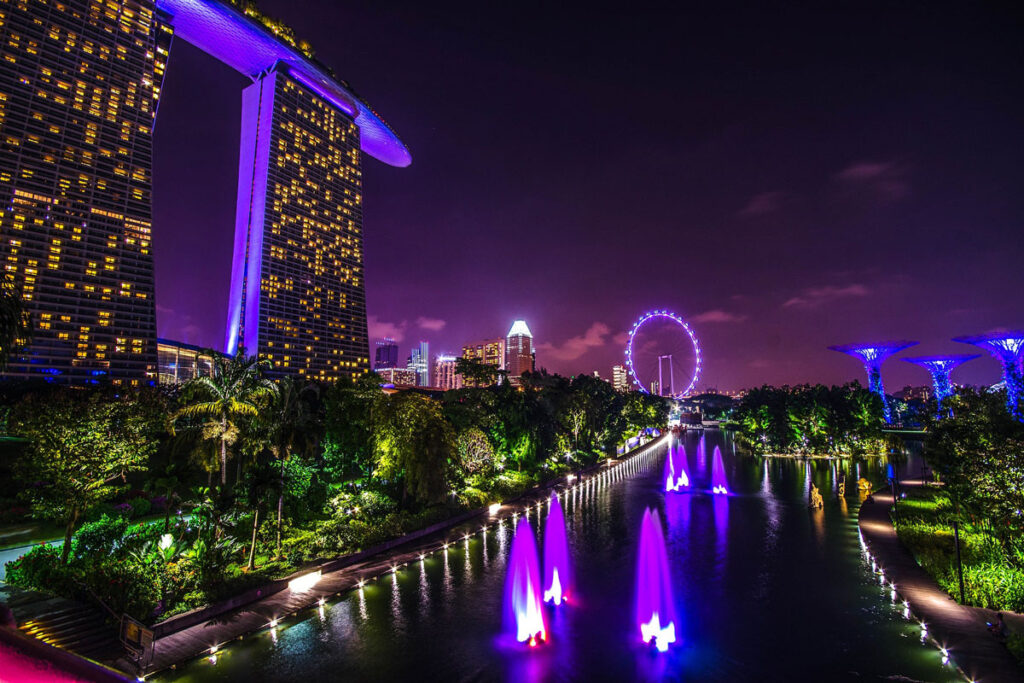
Pricing
Singapore is notoriously pricey. At luxe tourist destinations around town, you can expect prices on par with cities like New York or London.
However, it’s easy to save money when planning meals. The city’s robust ethnic neighborhoods serve up some of the best food in town, all for very reasonable costs.
Tipping is not customary in Singapore, although it’s always appreciated for acknowledging a job well done.
Bring a Cover Up
Remember to bring a cover-up for visiting any of the city’s many temples. As with any house of worship, it’s respectful to not show too much skin while inside. A simple scarf or light jacket will do — just ensure you’ve covered your shoulders and legs above the knee.
Laws and Fines
Singapore has a reputation for being notoriously strict, in order to maintain its law-abiding society and spotless topography. Truly, you won’t see a single piece of trash in the entire country!
Just conduct yourself with common decency while here, and you’ll be fine. However, it’s worth noting the following rules:
- Littering: fines can reach up to $1,100 if you’re spotted littering. Be a good person (as you should anywhere in the world) and carry your trash to a receptable.
- Chewing gum: both the sale and import of chewing gum is illegal in Singapore, which effectively bans it entirely. If you happen to have gum on you, don’t chew it while here (thus giving away that you brought it into the country).
- Eating and Drinking on Public Transit: steep fines are issued to anyone caught consuming food or drink on public transportation. Rather than tuck leftovers into your bag, make sure you finish everything before boarding, to avoid risking a spill.
- Jaywalking: again – illegal. Use designated crosswalks to avoid being slapped with a ticket.
- Smoking and drugs: Smoking is only legal in designated areas, and anyone lighting up outside these perimeters will be punished. And don’t even think about buying, selling, or having drugs on your person. The prosecution for this offense is considered one of the strictest in the world, regardless of whether you’re a local or foreigner.
3 Days in Singapore
Flex Day (either day #1 or day #3): Colonial Quarter

The traditional Colonial Quarter sits in the heart of the city center, a 20-minute walk from the Marina Bay Sands. If you arrive early enough on day #1, you can visit this neighborhood prior to the evening activities highlighted below. Otherwise, you can explore on day #3, before your departure.
While not an ethnic neighborhood per se, this historic district is still unique in its own right. The Colonial Quarter maintains its own distinctive character, with a rich architectural heritage that reflects the city’s former rulers.
You’ll find stunning British colonial designs, particularly at St. Andrew’s Cathedral (one of the oldest churches in Singapore, dating to 1837) and the National Museum. You can easily pass a few hours at the museum, which highlights the history and culture of Singapore and its people.
Raffles Hotel

One of the crown jewels of the Colonial Quarter is the stately Raffles Hotel, which retains the same grace and charm as when it opened back in 1887.
The Raffles encompasses an entire city block, and includes an extensive shopping arcade and numerous chic dining options. Beyond the posh on-site restaurants, you can also enjoy afternoon tea in the grandiose lobby, or grab a drink and nibbles in one of the timeless cocktail lounges.
Most tourists make their way to the Long Bar, which invented the Singapore Sling in 1915. A gin-based concoction with brandy and tropical juices, the Singapore Sling is now considered the national drink. Ordering one will set you back a whopping S$42 (!!) but for many people it’s the experience that matters. Indeed, sitting in the 135-year-old watering hole, munching on the complimentary peanuts and tossing back the famous drink in its ancestral home, is a fun time.
Day #1: The Iconic Highlights and Top 3 Photo Spots
We’ve structured this itinerary to ensure you see all the top highlights on your first day in the city. Most of them are best enjoyed in the evening hours anyway, so it works well with the assumption that you’ll arrive in Singapore midday.
Tip: If you have the energy to experience Singapore nightlife tonight, start this itinerary in the order it’s written. If, however, you’re jetlagged and want to make it an early night, simply reverse the order. Start at the Quays and end at Gardens by the Bay, where the last light show concludes at 9 p.m.
As mentioned above, if you arrive earlier in the day, start by visiting the Colonial Quarter before beginning the itinerary below.
Marina Bay Sands Hotel
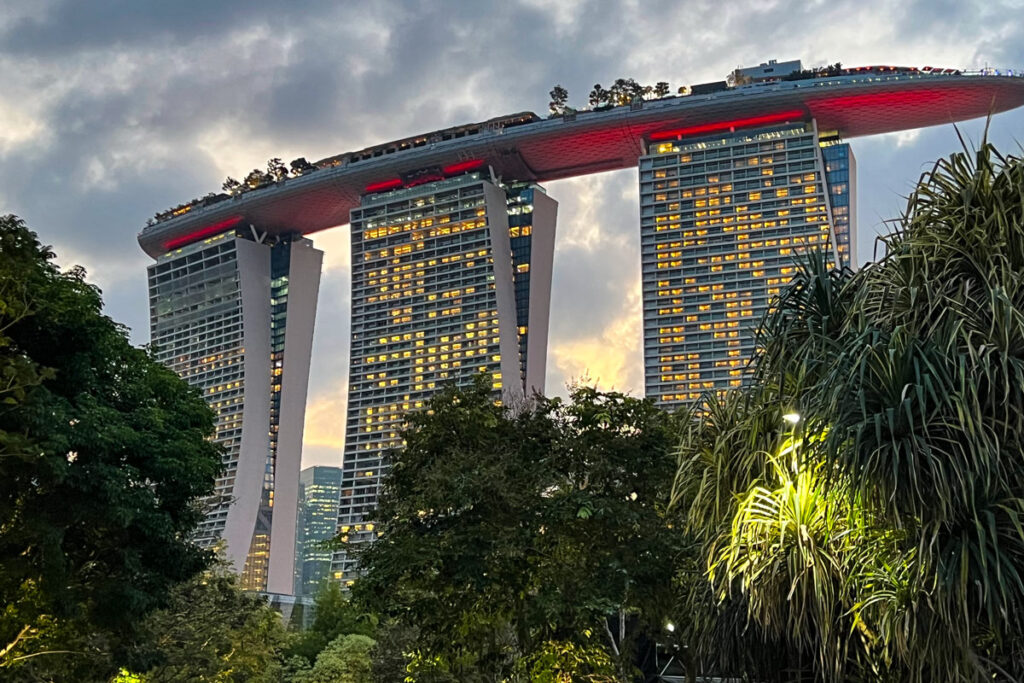
Kick off your time in Singapore with a one-two punch of the two most notable landmarks along the city skyline. Marina Bay Sands is a massive luxury hotel that has come to symbolize the city’s opulence and modernity.
Some may prefer a quick stroll through the swanky concourse, while others will want to linger and explore. For the latter group, the hotel is a destination in itself, with first-rate dining, designer-brand shopping, and more. You can visit the on-site ArtScience Museum, take a sampan ride through the man-made indoor canal, and explore rotating shows and exhibits.
The highlight of Marina Bay Sands experiences, however, is the SkyPark Observation Deck. Sitting 56 stories up, it hosts glittering panoramas of the cityscape below. Evening ticket prices run $36 per adult, but many consider it to be a must-see attraction while in town. (We told you Singapore isn’t cheap!)
Once you’ve had your fill of the Sands, make your way across the pedestrian bridge to Gardens by the Bay.
Gardens by the Bay

No trip to Singapore is complete without experiencing Gardens by the Bay. Despite only opening in 2012, this one-of-a-kind nature park has become one of the most iconic symbols of the city. The full complex is over 100 hectares (250 acres) and includes multiple themed gardens, along with state-of-the-art conservatories and greenhouses. The Cloud Forest and Floral Fantasy are especially worth visiting (for an extra fee).
Tip: time your visit so you can experience the dazzling Garden Rhapsody light and sound show, which runs every night at 7:45 p.m. and 8:45 p.m. Aim to arrive in early evening, when there’s still an hour or two of daylight left to explore the gardens. Then, finish your visit with the Garden Rhapsody show as a mesmerizing cap to your time here.
Merlion Park
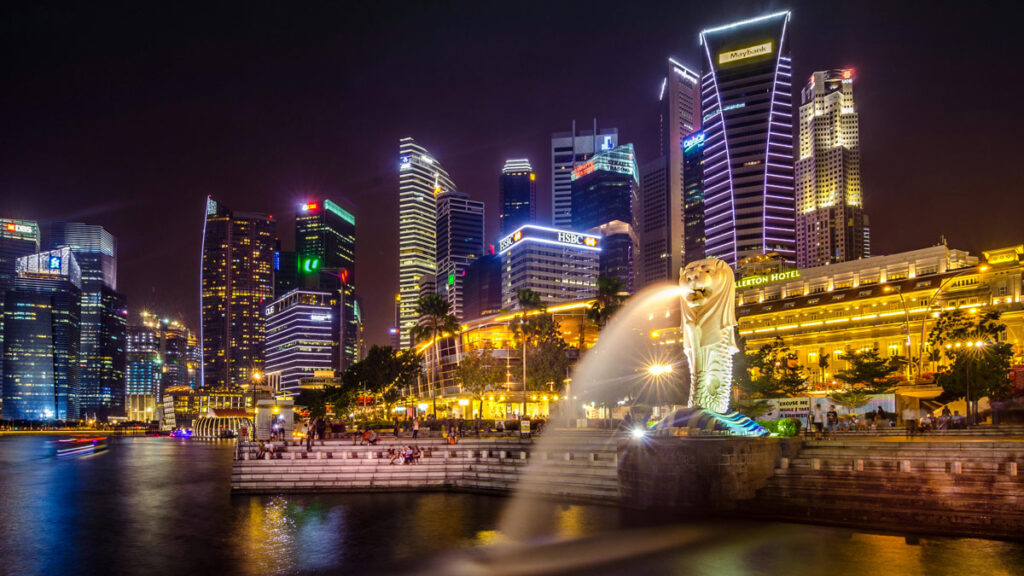
After Gardens by the Bay, cross over Marina Bay to Merlion Park, which sits at the confluence of the Singapore River.
While there isn’t too much to see within Merlion Park, it makes for a delightful stroll along the waterfront. The park is also home to the Merlion statue, the third and final of Singapore’s famous landmarks on your tour this evening.
The merlion is a mythical creature that serves as a symbol of Singapore. It has the head of a lion (an ode to its original name of “Lion City”), with the body of a fish to denote its origins as a small fishing village.
The statue stands 8.6 meters tall and doubles as a fountain, spouting water into Marina Bay below. It’s one of the most popular images of Singapore, and worth snapping the iconic photo while you’re here.
Tip: you can also watch the Gardens by the Bay nighttime light show from here, looking across Marina Bay. So if you’re ahead of schedule, and don’t want to waste time waiting for the show within the Gardens, you can also continue on your tour and catch the spectacle from across the water.
Boat, Clarke, and Robertson Quay

From Merlion Park, head east along the Singapore River Walk for 600 meters, where you’ll arrive at Boat Quay.
The quays were originally a major trade center during the colonial period, and have been revitalized as a trendy entertainment district. Today, you’ll find hip restaurants and nightclubs, along with museums, shopping, and other recreational activities.
Boat Quay is the first district you’ll come to. If you want to explore further, you can also continue on to Clarke Quay (800 meters past Boat Quay) and Robertson Quay (750 meters beyond that).
With a buzzing nightlife scene, the quays are especially popular in the evening. Linger here as long as you wish, before returning to your hotel for the night.
Note: if you did this day #1 itinerary in reverse, you can just as well start at the Quays. Enjoy the daytime hours at one of the many trendy coffee shops or cafes, or pop into the riverfront shops and museums. River cruises are also popular, and you’ll find tour operators at each of the different quays.
Day #2: Ethnic Neighborhoods
For your fullest day in Singapore, set off to explore its bustling ethnic neighborhoods, including Chinatown, Little India, Kampong Gelam, and Katong-Joo Chiat. This itinerary is organized in geographic order, to minimize time spent in transit.
If you’re running short on time, you can always skip over one neighborhood or another. But we definitely encourage you to see as many as you have the time and energy to do. These charming districts each have a distinctive character, and together they provide a more comprehensive understanding of Singapore’s rich history and culture.
Chinatown
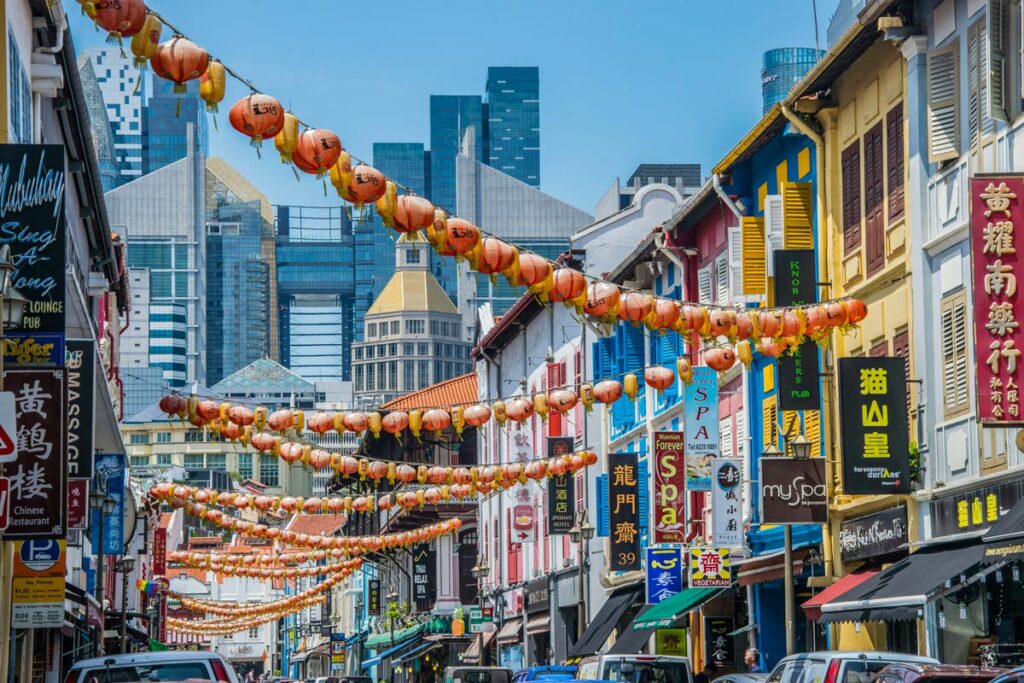
Buzzy Chinatown is one of Singapore’s most established neighborhoods. The city blocks here are alive with street vendors and markets, ornate temples and mosques, and colorful street art. In between, you’ll also find plenty of traditional cuisine, from satisfying street food to trendy Michelin-star restaurants.
The unofficial anchor of Chinatown is the Buddha Tooth Relic Temple and Museum, which is a beautiful example of classic Chinese Buddhist design. For additional houses of worship, you can also visit Thian Hock Keng (the city’s oldest Chinese temple), Sri Mariamman (the oldest Hindu temple), or Masjid Jamae (one of the oldest mosques).
For a true Chinatown shopping experience, head to the Chinatown Street Market, where you’ll find a maze of alleyways, packed with stalls selling everything from cheap knick-knacks to more quality wares. It’s a great spot to pick up a unique souvenir.
Additionally, if you want to purchase one of the custom suits that Singapore is renowned for, many of the best tailors are in Chinatown. We visited Edit Suits Co., where my husband was thrilled with his made-to-order tuxedo. They painstakingly work with you to select your preferred fabrics and take detailed measurements, before shipping the finished product to your home address. It all comes at a much lower price than you’d pay back home.
If you’re ready for a bite to eat, you’ll find plenty of traditional comfort dishes at the Chinatown Complex, Amoy Street Food Centre, or Maxwell Food Centre food halls. Or, for finer dining, head to either Kok Sen, The Blue Ginger, or Restaurant Ibid for trendy takes on Chinese Singaporean cuisine.
Little India

Little India is one of Singapore’s most colorful districts, with an enduring heritage befitting the city’s dynamic Indian community.
Two of the must-see stops include the ornate Sri Veerakaliamman Temple and, just across the block, Tan Teng Niah House.
Sri Veerakaliamman Temple, built in 1855, is one of the oldest temples in Singapore. The roof makes a stunning photo op — sculpted entirely of bright figurines, the amount of detail is almost dizzying.
Likewise, Tan Teng Niah House absolutely bursts with color. Built in 1900 for a prominent local Chinese businessman, it’s impossible to not smile at the cheerfully-painted exterior. The kaleidoscopic villa has also seen a resurgence in popularity with Instagrammers, although it makes for a vivid photo for any group.
To learn more about Singapore’s vibrant Indian community, drop into the Indian Heritage Centre. The museum relays the local history through rich exhibits, galleries, and various events throughout the year.
Much of Little India’s best shopping experiences have a heavy cultural lean. For the most authentic experience, pop in to either the Mustafa Centre and Little India Arcade. You can easily pass an hour or two, perusing aisles brimming with everything from jewelry and clothing, to textiles and décor.
Foodies also have much to love about Little India, where the cuisine highlights a rich array of spices and flavors from the Indian subcontinent. Bismillah Biryani is a frequent Michelin Bib Gourmant awardee, dishing up classic dum biryani rice plates. Cheap comfort food abounds at the Tekka Centre food court, where hawker stalls have been serving traditional eats for decades. Or for more elevated dining, head to trendy Podi & Poriyal, which offers modern takes on traditional fare.
Kampong Gelam
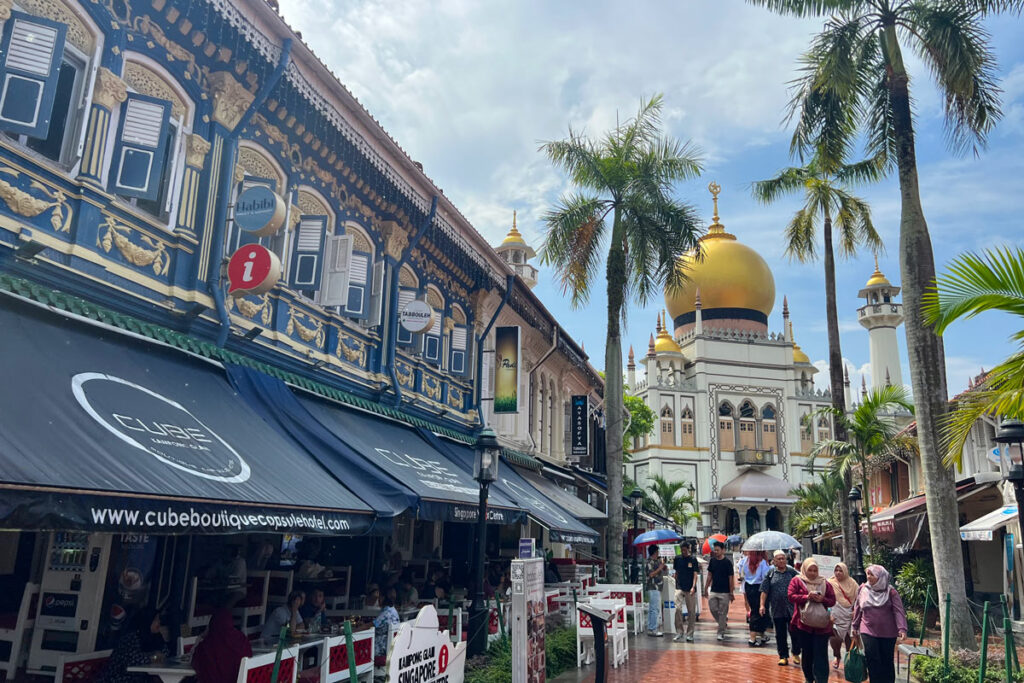
The oldest urban quarter in Singapore, today Kampong Gelam comprises the Arabic district. This vibrant neighborhood is reminiscent of a Middle Eastern bazaar, with bustling marketplaces and cafes serving up delectable Turkish delight and strong Arabic coffee.
Start your tour at Sultan Mosque, the symbolic anchor of the neighborhood. From here, you can branch out to the streets and pedestrian avenues that run perpendicular to the temple. Bussora Street, which runs straight down from the mosque, is a pedestrian-only promenade full of enticing cafes and eateries. It also makes a great photo op, looking back up the street towards Sultan Mosque.
Arab Street is home to numerous shops and boutiques with a cultural bent, including colorful textiles, lanterns, and more.
Haji Lane is one of Singapore’s trendiest corridors, with a long-standing reputation for hip, indie shops and cafes, along with alternatively funky and elaborate street art.
For a fun peek back in time, visit the Malay Heritage Center which is housed in the former residence of the Sultan of Singapore. Originally built in 1819, it’s now a national monument with both permanent and rotating exhibits that explore the history of the region. (Note: closed for renovations in 2025 — check before you go!)
If you’re getting hungry, we recommend either The Coconut Club or Hjh Maimunah, both of which have made the Michelin Bib Gourmand list for their traditional nasi (rice) dishes. Alaturka is another tasty spot (and Bib Gourmand approved) for traditional Turkish flavors, including meze platters, falafel, kebabs, and more.
Katong-Joo Chiat
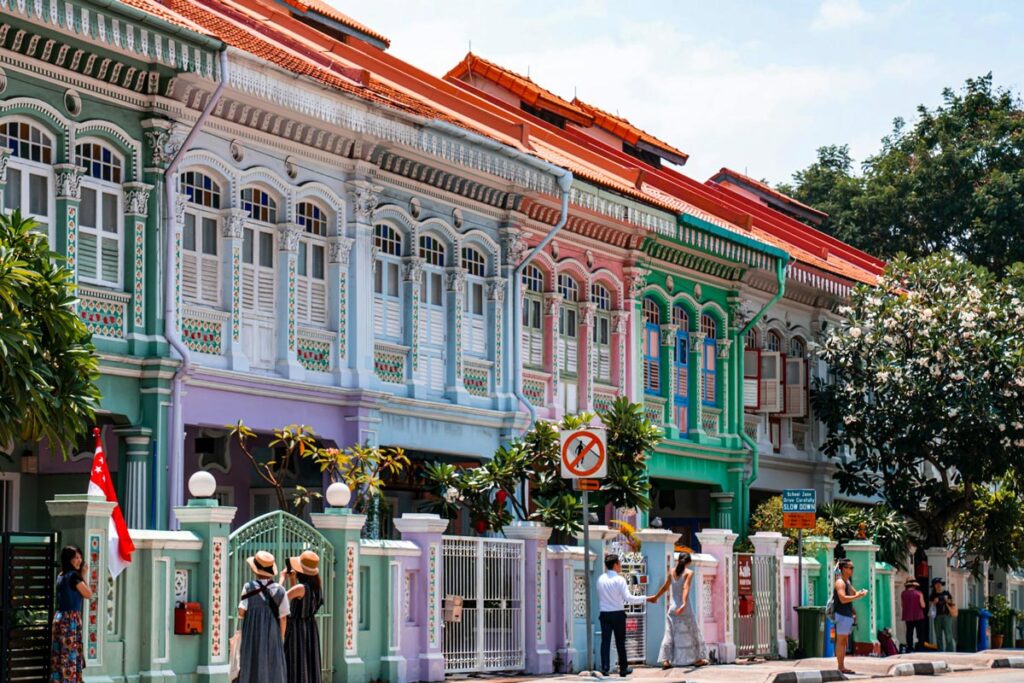
The culture of Katong-Joo Chiat belongs to the Peranakans, who have an equally rich heritage, despite not being as well known outside the region. This group of ethnic Chinese, who were some of the first to settle southeast Asia and inter-marry with the local Malays, also maintain their own historic quarter in Singapore.
Today, Katong-Joo Chiat is one of the hippest neighborhoods in the city, with an eclectic blend of buzzy coffee shops, trendy eateries, and funky boutiques.
The iconic photo (and one of the most famous images of Singapore) is the cheerfully-painted pastel row homes on Koon Seng Road, colloquially termed the Peranakan houses. Often called the “prettiest street in Singapore,” these homes perfectly blend the Chinese and Malay elements that have come to define the one-of-a-kind Peranakan architectural style. Directions.
For Instagram-worthy street art, head to East Coast Road and Joo Chiat Road, where you’ll find colorful, detailed murals on many of the buildings that line these main thoroughfares.
If you want to take a deeper dive into the history of the Peranakan people, we recommend either The Intan, Katong Antique House, or Straits Enclave museums, all of which are housed in traditional homes and do a wonderful job upholding the culture’s unique heritage. Additionally, the Eurasian Heritage Gallery explores the Eurasian culture of Singapore, and how this melting pot of cultures has contributed to the dynamic city of today.
Chic boutiques are also plentiful in Katong-Joo Chiat. Cat Socrates is one of the most famous, retailing quirky gifts and home goods. We also love Onlewo for its Peranakan-themed home goods, which all come in bright, colorful prints and designs. Or for an edible souvenir, swing by Embrace Chocolate. All of their small-batch chocolate bars are made with top-quality cacao, along with organic sugar and zero additives.
If you’re hungry, head to 328 Katong Laksa, which is arguably our favorite comfort food spot in the city. This traditional dish is comprised of noodles and prawns swimming in rich coconut broth; you’ll get a satisfying meal for a reasonable price. 328 Katong Laksa has made quite a name for itself — photos of celebrity visitors line the walls, with everyone from Gordon Ramsay to Anthony Bourdain.
For other local flavors, we recommend either Beach Road Prawn Noodle House for their prawn mee (literally, prawn noodles) or Mr. and Mrs. Moghan Roti Prata, which serves up the classic flaky flatbread.
You can finish it all off with a cool treat from trendy Birds of Paradise, which dishes up artisan gelato infused with unique botanicals.
Day #3: Singapore Botanic Gardens, Jewel at Changi Airport
Note: if you missed visiting the Colonial Quarter on day #1, be sure to check it off today, prior to your departure. You can read more at the Colonial Quarter section above.
Otherwise, today offers a more languid schedule, to allow you flexibility before your flight home.
Singapore Botanic Gardens
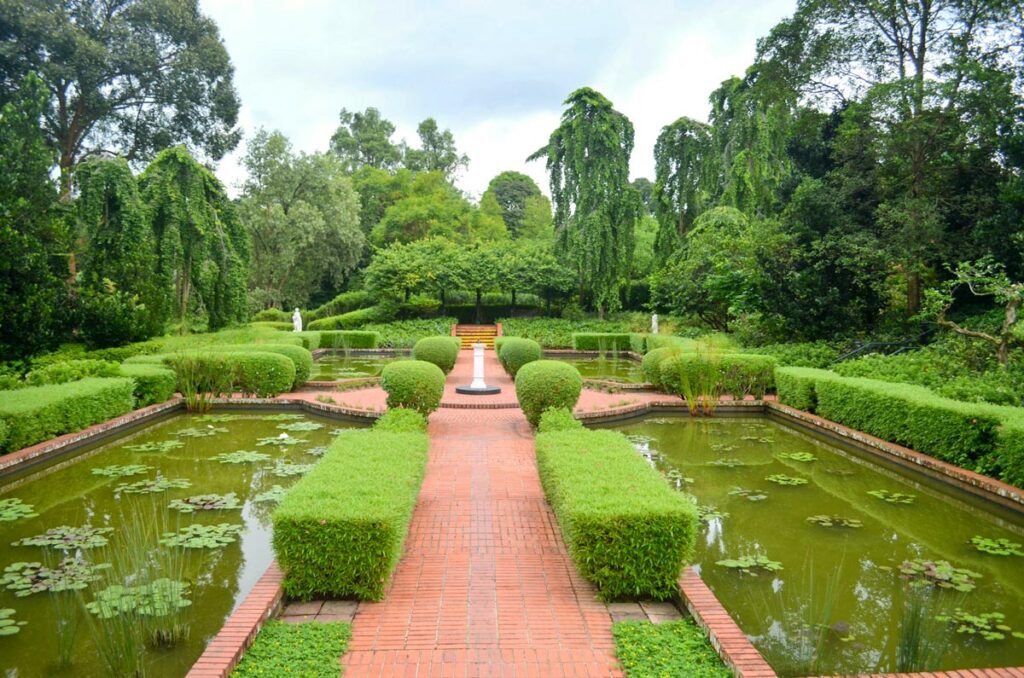
The Singapore Botanic Gardens can often be overlooked by tourists, as it sits a bit off the regular circuit. From the city center, it’s about a 15-minute drive or 30-minute public transit ride. However, locals know the true value of this gem, which is the only tropical garden to be named a UNESCO World Heritage Site.
Originally founded in 1859, it now encompasses over 80 hectares (200 acres) and is home to the National Orchid Garden, as well three different lakes, the Corner House (an old colonial home-turned-Michelin-star restaurant), a tropical rainforest, and more. Sometimes you can even catch a free weekend concert at the Symphony Stage.
Give yourself ample time to explore this special spot.
Jewel at Changi Airport
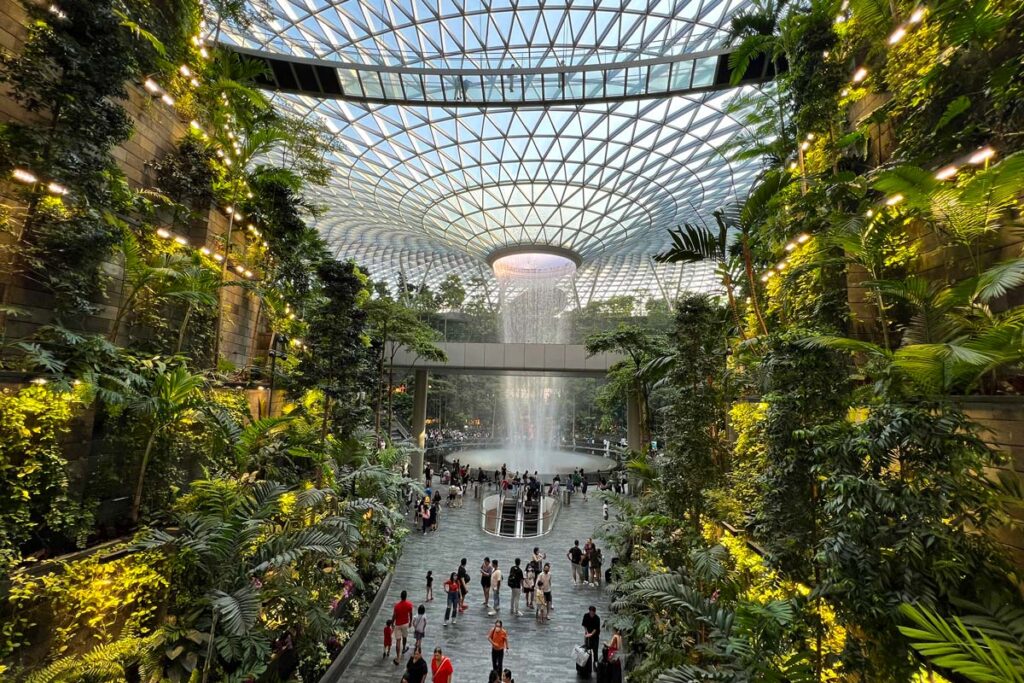
Jewel is located at Changi Airport, and is not to be missed. When heading to catch your flight home, make sure to arrive early. You’ll want to allow an extra 1-2 hours to explore this extravagant complex.
Just opened in 2019, Jewel is a full entertainment and retail mall, with everything from 300 dining and retail outlets and an on-site hotel, to a five-story indoor forest, hedge maze, canopy rope course, and more.
However, the main attraction is the Rain Vortex, the world’s tallest indoor waterfall, which cascades 40 meters (130 feet) from the glass ceiling. It truly needs to be seen to be believed. (You can also admire the Rain Vortex up close by catching a ride on the Changi monorail, which glides just past the funnel at eye-level).
Once it’s time to catch your flight, you can connect to any of Changi’s terminals from Jewel via pedestrian access bridges.
